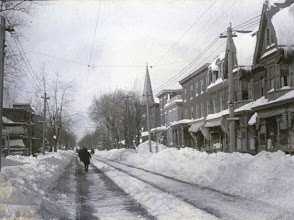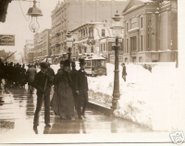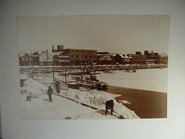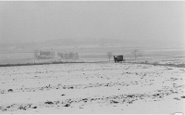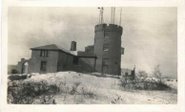Winter '22 / '23 - An over-the-horizon look at early autumn's a priori climate conditions
 |
| near Woodstock ... VT Marion Post Wolcott (1940) |
Snowfall forecasting contests for 27 stations across New England and the Mid-Atlantic regions ... since 1999
 |
| near Woodstock ... VT Marion Post Wolcott (1940) |
-19.14 (just inside 1-sigma from the mean)
OCT is now the 5th month with a QBO index below zero having flipped in JUN following its 14 month run in positive territory. The 30mb flow over the Equator oscillates from east to west every 14 months; therefore ... the current easterly state of the QBO is expected to last throughout Winter '21 / '22.
Leading analog years
Winter / ENSO (MEI)
72-73 / W+
00-01 / C-
09-10 / W
91-92 / W+
58-59 / W-
With La Nina temperature anomalies in ENSO Region 3.4 expected to
persist through at least late winter ... all QBO analog years are
rejected except Winter 00/01.
- Winter '00 / '01
The sum-total of the season-total snowfall for all Contest forecast stations was 1,312". (~21% above the 1968 - 2021 period-of-record average 1,085".
Eurasia/s OCT areal snow cover slightly below normal.
D-J-F Index Averages
AO: -1.312
NAO: +0.040
NOV: +2.54 🔥🔥🔥
Only two other NOVs had a higher index ('78 +3.04; '93 +2.56)
TL;DR This winter/s average NAO index expected to be positive ( >0 ).
---
Analogs and weights for composites:
'03 / '04 (1)
'99 / '00 (1)
'91 / '92 (1)
'93 / '94 (1)
'15 / '16 (1)
Each analog's average NAO for D-J-F was > 0.
NAO/s analog winters are assessed against the upcoming winter/s expected states of:
- ENSO (MEI moderate - trending weak La Nina)
- QBO-W < 10
- PDO (cool)
We removed '03 / '04 ... '91 / '92 ... and '15 / '16 from further consideration b/c they were +ENSO winters. Winter '93 / '94 had QBO-E so it too drops out.
Winter '99 / '00 survives with its weak La Nina --- QBO-W < 10 ... and a cool PDO.
Analog years and weights for composites:
'89 / '90
(3) ... '90 / '91 (2) ... '97 / '98 (2) ... '02 / '03 (1) ... and '15 / '16 (1).
Arctic Oscillation (AO) analog composites of 500 mb (5H) geopotential height anomalies (GPHa) and 2-meter air temperature anomalies (2m Ta) for Winter '20 / '21.
5H GPHa weighted-composite2m Ta weighted-compositeAO analog data table (unranked)
NOV-19 AO: -1.193
Same analog years as those associated with AO/s OCT-19 analysis but with a shuffled ranking.
Through a careful multi-variate analysis of key teleconnection
indices and the process of elimination ... we/ve settled on the '04 /
'05 winter as this winter/s leading analog for the Contest/s forecast area.
Bottom line up front:
- Temperature: near normal except below normal over far northern stations
- Snowfall:
Above normal - northern half of forecast area
Normal to below normal - southern half of forecast area
---
Consensus of dynamic and statistical model outlooks
ENSO: La Nada+ (0.5°C < ENSO Region 3.4 SSTa < 0.5°C)
Current PDO state (OCT-to-MAR) < 0
2019 trend analysis
QBO: W (+) going E (-)
2x2 contingency table (Chi-SQ Test for Independence) AO NAO
If NOV AO < 0 then 71% probability D-J-F average AO < 0
If NOV NAO > 0 then 73% probability D-J-F average NAO > 0
The analog winter/s key features follow:
ENSO: +0.5°C (lowest threshold of weak El Niño)
MEI: La Nada+
QBO: W (+) going E (-)
PDO < 0
AO < 0
NAO > 0
EPO < 0
Contest stations' cumulative season-total snowfall: 1,446" (AVG: 1,095")
Winter '04 / '05 - 5H GPHa (l) & 2mTa (r)
Negative 5H GPHa - W & Negative 5H GPHa - E ==> Trof-W / Trof-E
Neutral 2mTa over east coast; negative 2mTa over New England
---
Winter '04 / '05 monthly anomalies (D-J-F)

DEC '04 - 5H GPHa (l) & 2mTa (r)
Positive 5H GPHa - W & Negative 5H GPHa - E ==> Ridge-W / Trof-E
Negative 5H GPHa INVOF Greenland ==> NAO > 0
Positive 5H GPHa INVOF Gulf of Alaska & Positive 5H GPHa eastern ATL ocean ==> AO > 0
Positive 5H GPHa INVOF Gulf of Alaska & negative 5H GPHa INVOF Hawaii ==> EPO < 0
Negative 2mTa over SE and Gulf Coast

JAN '05 - 5H GPHa (l) & 2mTa (r)
Negative 5H GPHa - W & Positive 5H GPHa - E ==> Trof-W / Ridge-E
Negative 5H GPHa INVOF Greenland ==> NAO > 0
Positive 5H GPHa INVOF Gulf of Alaska & Positive 5H GPHa eastern ATL ocean ==> AO > 0
Positive 5H GPHa INVOF Gulf of Alaska & negative 5H GPHa INVOF Hawaii ==> EPO < 0
Positive 2mTa over SE and Gulf Coast; negative 2mTa over NE CONUS
FEB '05 - 5H GPHa (l) & 2mTa (r)
Negative 5H GPHa - W & Negative 5H GPHa - E ==> Trof-W / Trof-E
Positive 5H GPHa INVOF Greenland ==> NAO < 0
Negative 5H GPHa INVOF Gulf of Alaska & Negative 5H GPHa eastern ATL ocean ==> AO < 0
Neutral 2mTa over east coast; positive 2mTa over NE CONUS
---
Key
5H - 500 mb
2mT - 2 meter temperature
2mTa - 2 meter temperature anomaly
GPHa - geopotential height anomaly
ENSO - El Nino Southern Oscillation
MEI - Multivariate ENSO Index
AO - Arctic oscillation
NAO - North Atlantic oscillation
EPO - Eastern Pacific oscillation
PDO - Pacific Decadal oscillation
CONUS - continental United States
INVOF - in the vicinity of
Arctic Oscillation (AO) composites of 500 mb (5H) geopotential height anomalies (GPHa) and 2-meter air temperature anomalies (2m Ta) for analog winters '53 / '54 ... '54 / '55 ... '59 / '60 ... '97 / '98 ... '14 / '15.
UPDATE (31-OCT-19)
Dr. Cohen via Tweeter ..."... the snow cover advance index came in at +0.6.
"This does suggest a negative winter Arctic Oscillation and upcoming #PolarVortex disruption."
Analog 5H composite ('53/'54 ... '54/'55 ...'59/'60 ... '97/'98 ... '14/'15) ... as of SEP-19
AUG AO: -.722
Leading analog contenders ... as of AUG-19.
The analog forecasting technique seeks associations to the AO state in the run-up to the coming winter with AO run-up states of past winters. Presented here is the verification of AO analogs for the '18 /'19 winter.
The NEWxSFC method ranks analog years by their the sum of square errors (SSE) statistic.
Lower SSE errors ==> stronger analog
Constraining the number of analog winters for analysis to five is arbitrary.
In the run-up to Winter '18 / '19 ... '55 / '56 was the leading analog followed by '64 / '65 ... '84 / '85 ... '99 / '00 ... and '91 / '92. Observed AO values for Winter '18 / '19 began neutral in DEC ... turned weakly negative in JAN ... then surged positive at meteorological winter/s end and into MAR.
Rookie 1
Intern -
Journey 1
Senior 10
GOVT 1
PWSP -
TOT 13
Welcome Rookie forecaster Hollowman501
Good Luck!
Forecaster table ranked ascending by storm-total precipitation (STP)
Correction: The forecaster class for JessicaCain should be 'Journeyman.'
Rookie 1
Intern 1
Journey -
Senior 11
GOVT 1
PWSP 1
TOT 15
Welcome Rookie forecaster chefjustin.
Good Luck!
Forecaster table (supposed to be) ranked ascending by storm-total precipitation (STP)*
* didn't come off the printer quite right
NOV/s Arctic Oscillation (AO) Index: -1.116
Conventional meteorological wisdom holds the state of winter/s AO is next to impossible to forecast.
Some use analogs. The analog forecasting methods seeks similarities between the AO state in the run-up to the coming winter with AO run-up states of winters past. The NEWxSFC method ranks analog years by their sum of square errors (SSE) statistic.
Lower SSE errors ==> stronger analog
Constraining the number of analog winters for analysis to five is arbitrary.
See this year's analogs below.
The analog forecasting technique seeks similarities to the AO state in the run-up to the coming winter with AO run-up states of winters past. Presented here is the verification of AO analogs for the '17 /'18 winter.
The NEWxSFC method ranks analog years by their the sum of square errors (SSE) statistic.
Lower SSE errors ==> stronger analog
Constraining the number of analog winters for analysis to five is arbitrary.
 |
| Arctic Oscillation (AO) Index Analog Forecast Verification |
 An alternative forecasting technique looks at the AO/s 'sign' (i.e., positive or negative) for any calendar-year's month preceding the pending winter as a potential leading indicator of the AO's sign for upcoming D-J-F period.
An alternative forecasting technique looks at the AO/s 'sign' (i.e., positive or negative) for any calendar-year's month preceding the pending winter as a potential leading indicator of the AO's sign for upcoming D-J-F period.The analog forecasting technique seeks similarities to the NAO state in the run-up to the coming winter with NAO run-up states of winters past. Presented here is the verification of NAO analogs for the '17 /'18 winter.
The NEWxSFC method ranks analog years by their the sum of square errors (SSE) statistic.
Lower SSE errors ==> stronger analog
Constraining the number of analog winters for analysis to five is arbitrary.
 |
North Atlantic Oscillation (NAO) Index Analog Forecast Verification
|
Something worth keeping an eye on ...
NOV/s Arctic Oscillation (AO) Index: -0.078















